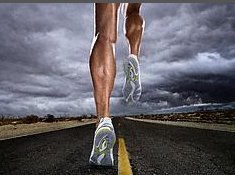How to jogg
When and how to jog
You will need to choose an appropriate time of the day to jog. One in which it is realistic to take time. For this reason many people jog the first thing in the morning. Others find their lunch hour an appropriate way to work out and reduce calories simultaneously. Some prefer the evening as it allows an effective way to "rejuvenate" between leaving work and entering the evening.
The Mechanics of Jogging
Proper mechanics are important for efficient, gentle, silent jogging. The ultimate goal is to jog with ease and animal grace.
1. Hold your back straight. Stand nearly erect. This will allow you to develop a smooth and even stride. For many this will require strengthening the abdominal muscles and losing weight.
2. The length of your stride (measured from the point where your right foot touches the ground to the point where it touches again) should about equal your height.
3. Your foot should touch the ground with the weight towards the rear , either in a heel-toe motion or more flat-footed. Your leading foot should come down just about under your knee.
4. Landing on your toes is not advised because it throws all the weight onto the small bones at the front of your foot. This works against the natural lever-action of your foot and may lead to injury.
5. "Jog gently, Jog silently" means not to pound along the path. Don't slap your feet. Follow through on your stride so that your foot lands without being driven into the earth and jarring your entire body. Become light and smooth. As your foot makes contact your center of gravity should be over it or slightly ahead. Accomplish this by leaning slightly forward and by allowing your legs to work as pullers, not pushers. As strange as it may seem, a muscle cannot push, it can only pull.

